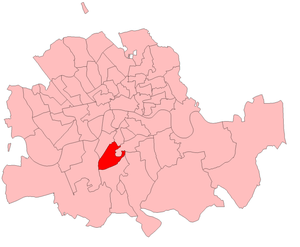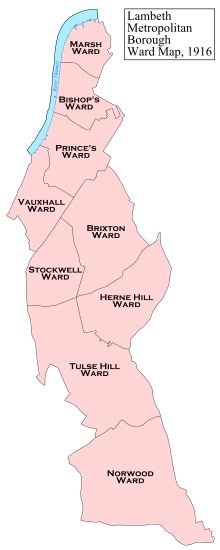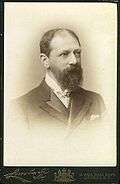Brixton (UK Parliament constituency)
| Brixton | |
|---|---|
|
Former Borough constituency for the House of Commons | |
| County | Greater London |
| 1885–1974 | |
| Number of members | One |
| Replaced by | Lambeth Central |
| Created from | Lambeth |
Brixton was a parliamentary constituency centred on the Brixton district of South London. It returned one Member of Parliament (MP) to the House of Commons of the Parliament of the United Kingdom, elected by the first-past-the-post system.
History
The constituency was created for the 1885 general election, and abolished for the February 1974 general election, when it was largely replaced by the new Lambeth Central constituency.
Boundaries
1885–1918

The constituency was created by the Redistribution of Seats Act 1885, when the existing two-member Parliamentary Borough of Lambeth was divided into four single-member divisions.[1][2] The seat, formally known as Lambeth, Brixton Division, comprised part of the civil parish of Lambeth, and was defined in terms of the wards used for elections to the parish vestry under the Metropolis Management Act 1855 as follows:
- The parts of Brixton and Stockwell wards to the north of the centres of Acre Lane and Coldharbour Lane
- The part of Vauxhall ward to the east of the centre of Clapham Road.[1][2]
1918–1950


The Representation of the People Act 1918 redrew constituencies throughout Great Britain. In London, the seats were redefined in terms of the wards of the Metropolitan Boroughs of the County of London, which had been created in 1900. Accordingly, the constituency was defined as consisting of the following areas of the Metropolitan Borough of Lambeth:
- Stockwell ward.
- The part of Brixton ward to the south of a line running from Clapham Road along the middle of Stockwell Park Road, Grove Road, Brixton Road, Mostyn Road, Akerman Road and Lothian Road and across Camberwell New Road to Wyndham Road.
- The part of Herne Hill Ward to the north of a line running from Coldharbour Lane along the north side of the London, Brighton and South Coast Railway to Denmark Hill.
- The part of Tulse Hill to the north and west of a line running along the middle of Brixton Hill from Mill Lane to Water Lane, along the middle of Water Lane to Effra Road, and along the middle of Effra Road to Coldharbour Lane.[2][3]
1950–1974

The final boundary change was made by the Representation of the People Act 1948, and came into effect at the 1950 general election. The 1948 Act introduced the term "borough constituency". Due to a population decrease in Lambeth, the number of constituencies in the borough was reduced from four to three. The new Lambeth Brixton Borough Constituency was defined as consisting of four wards of the metropolitan borough as they existed at the end of 1947:
Local government was completely reorganised in Greater London in 1965, and the metropolitan borough was abolished to be replaced by the larger London Borough of Lambeth. However these changes were not reflected in parliamentary boundaries until the general election of 1974. The Brixton constituency was largely replaced by the new seat of Lambeth Central[2]
Members of Parliament
| Election | Member | Party | |
|---|---|---|---|
| 1885 | Ernest Baggallay | Conservative | |
| 1887 by-election | George Osborne, Marquess of Carmarthen, later Duke of Leeds | Conservative | |
| 1896 by-election | Evelyn Hubbard | Conservative | |
| 1900 by-election | Sir Robert Mowbray | Conservative | |
| 1906 | Joel Herbert Seaverns | Liberal | |
| 1910 | Davison Alexander Dalziel, later Baron Dalziel | Conservative | |
| 1923 | Frederick Joseph Laverack | Liberal | |
| 1924 | Davison Alexander Dalziel, later Baron Dalziel | Unionist | |
| 1927 by-election | Nigel Claudian Dalziel Colman | Conservative | |
| 1945 | Marcus Lipton | Labour | |
| Feb 1974 | constituency abolished: see Lambeth Central | ||
Election results
Elections in the 1970s
| General Election 1970: Lambeth, Brixton | |||||
|---|---|---|---|---|---|
| Party | Candidate | Votes | % | ±% | |
| Labour | Marcus Lipton | 13,053 | 57.3 | ||
| Conservative | James W. Harkess | 9,727 | 42.7 | ||
| Majority | 3,326 | 14.6 | |||
| Turnout | 43,372 | 52.5 | |||
| Labour hold | Swing | -4.0 | |||
Elections in the 1960s
| General Election 1966: Lambeth, Brixton | |||||
|---|---|---|---|---|---|
| Party | Candidate | Votes | % | ±% | |
| Labour | Marcus Lipton | 16,634 | 61.3 | ||
| Conservative | Piers John Shirley Dixon | 10,500 | 38.7 | ||
| Majority | 6,134 | 22.6 | |||
| Turnout | 47,615 | 57.0 | |||
| Labour hold | Swing | +3.2 | |||
| General Election 1964: Lambeth, Brixton | |||||
|---|---|---|---|---|---|
| Party | Candidate | Votes | % | ±% | |
| Labour | Marcus Lipton | 16,518 | 58.1 | ||
| Conservative | Kenneth P. Payne | 11,934 | 41.9 | ||
| Majority | 4,584 | 16.2 | |||
| Turnout | 49,903 | 57.0 | |||
| Labour hold | Swing | +5.0 | |||
Elections in the 1950s
| General Election 1959: Lambeth, Brixton | |||||
|---|---|---|---|---|---|
| Party | Candidate | Votes | % | ±% | |
| Labour | Marcus Lipton | 18,117 | 53.1 | ||
| Conservative | B. Warren | 16,005 | 46.9 | ||
| Majority | 2,112 | 6.2 | |||
| Turnout | 52,261 | 65.3 | |||
| Labour hold | Swing | -3.9 | |||
| General Election 1955: Lambeth, Brixton | |||||
|---|---|---|---|---|---|
| Party | Candidate | Votes | % | ±% | |
| Labour | Marcus Lipton | 20,594 | 57.0 | ||
| Conservative | William Lloyd Roots | 15,559 | 43.0 | ||
| Majority | 5,035 | 14.0 | |||
| Turnout | 53,045 | 68.2 | |||
| Labour hold | Swing | +0.9 | |||
| General Election 1951: Lambeth, Brixton | |||||
|---|---|---|---|---|---|
| Party | Candidate | Votes | % | ±% | |
| Labour | Marcus Lipton | 24,776 | 56.1 | ||
| Conservative | Patricia M. Marlowe | 19,423 | 43.9 | ||
| Majority | 5,353 | 12.2 | |||
| Turnout | 55,362 | 79.8 | |||
| Labour hold | Swing | +0.6 | |||
| General Election 1950: Lambeth, Brixton | |||||
|---|---|---|---|---|---|
| Party | Candidate | Votes | % | ±% | |
| Labour | Marcus Lipton | 24,015 | 52.8 | ||
| Conservative | Anthony Herbert Foord | 18,957 | 41.7 | ||
| Liberal | Enid Lakeman | 2,527 | 5.5 | ||
| Majority | 5,058 | 11.1 | |||
| Turnout | 56,082 | 81.1 | |||
| Labour hold | Swing | -8.1 | |||
Elections in the 1940s
| General Election 1945: Lambeth, Brixton | |||||
|---|---|---|---|---|---|
| Party | Candidate | Votes | % | ±% | |
| Labour | Marcus Lipton | 15,583 | 63.6 | ||
| Conservative | Nigel Claudian Dalziel Colman | 8,928 | 36.4 | ||
| Majority | 6,655 | 27.2 | |||
| Turnout | 37,493 | 65.4 | |||
| Labour gain from Conservative | Swing | +29.4 | |||
Elections in the 1930s
| General Election 1935: Lambeth, Brixton | |||||
|---|---|---|---|---|---|
| Party | Candidate | Votes | % | ±% | |
| Conservative | Nigel Claudian Dalziel Colman | 17,414 | 67.6 | ||
| Labour | Marcus Lipton | 10,908 | 36.1 | ||
| Liberal | Arthur S. Quick | 1,911 | 6.3 | ||
| Majority | 6,506 | 21.5 | |||
| Turnout | 51,713 | 58.5 | |||
| Conservative hold | Swing | -11.3 | |||
| General Election 1931: Lambeth, Brixton | |||||
|---|---|---|---|---|---|
| Party | Candidate | Votes | % | ±% | |
| Conservative | Nigel Claudian Dalziel Colman | 24,673 | 77.0 | ||
| Labour | Edward Albert Radice | 7,358 | 23.0 | ||
| Majority | 17,315 | 54.0 | |||
| Turnout | 52,569 | 60.9 | |||
| Conservative hold | Swing | +20.4 | |||
Elections in the 1920s
| General Election 1929: Lambeth, Brixton | |||||
|---|---|---|---|---|---|
| Party | Candidate | Votes | % | ±% | |
| Conservative | Nigel Claudian Dalziel Colman | 14,252 | 44.9 | ||
| Labour | A.B. Bishop | 10,089 | 31.7 | ||
| Liberal | Arthur S. Quick | 7,438 | 23.4 | ||
| Majority | 4,163 | 13.2 | |||
| Turnout | 50,956 | 62.4 | |||
| Conservative hold | Swing | -3.5 | |||
| Brixton by-election, 1927 | |||||
|---|---|---|---|---|---|
| Party | Candidate | Votes | % | ±% | |
| Conservative | Nigel Claudian Dalziel Colman | 10,358 | 48.1 | ||
| Labour | James Adams | 6,032 | 28.0 | ||
| Liberal | Frederick Joseph Laverack | 5,134 | 23.9 | ||
| Majority | 4,326 | 20.1 | |||
| Turnout | 39,953 | 53.9 | |||
| Conservative hold | Swing | -5.3 | |||
| General Election 1924: Lambeth, Brixton | |||||
|---|---|---|---|---|---|
| Party | Candidate | Votes | % | ±% | |
| Conservative | Sir Davison Alexander Dalziel, Bt. | 15,755 | 56.6 | ||
| Labour | J. Adams | 7,210 | 25.9 | ||
| Liberal | Frederick Joseph Laverack | 4,871 | 17.5 | ||
| Majority | 8,545 | 30.7 | |||
| Turnout | 40,134 | 69.4 | |||
| Conservative gain from Liberal | Swing | +18.9 | |||
| General Election 1923: Lambeth, Brixton | |||||
|---|---|---|---|---|---|
| Party | Candidate | Votes | % | ±% | |
| Liberal | Frederick Joseph Laverack | 10,881 | 53.5 | +8.3 | |
| Unionist | Sir Davison Alexander Dalziel | 9,476 | 46.5 | -8.3 | |
| Majority | 1,405 | 7.0 | 16.6 | ||
| Turnout | 39,189 | 51.9 | -0.9 | ||
| Liberal gain from Unionist | Swing | +8.3 | |||
| General Election 1922: Lambeth, Brixton | |||||
|---|---|---|---|---|---|
| Party | Candidate | Votes | % | ±% | |
| Conservative | Sir Davison Alexander Dalziel, Bt. | 11,284 | 54.8 | ||
| Liberal | Frederick Joseph Laverack | 9,316 | 45.2 | ||
| Majority | 1,968 | 9.6 | |||
| Turnout | 39,004 | 52.8 | |||
| Conservative hold | Swing | N/A | |||
Elections in the 1910s
| General Election 1918: Lambeth, Brixton | |||||
|---|---|---|---|---|---|
| Party | Candidate | Votes | % | ±% | |
| Coalition Conservative | Davison Alexander Dalziel | 9,902 | 61.3 | ||
| Independent | Stephen Kelley | 3,641 | 22.6 | ||
| Liberal | Horace Norton | 2,594 | 16.1 | ||
| Majority | 6,261 | 38.7 | |||
| Turnout | 37,745 | 42.8 | |||
| Coalition Conservative hold | Swing | N/A | |||
| General Election December 1910: Lambeth, Brixton | |||||
|---|---|---|---|---|---|
| Party | Candidate | Votes | % | ±% | |
| Conservative | Davison Alexander Dalziel | 4,770 | 56.3 | ||
| Liberal | Joel Herbert Seaverns | 3,702 | 43.7 | ||
| Majority | 1,068 | 12.6 | |||
| Turnout | |||||
| Conservative hold | Swing | +1.1 | |||
| General Election January 1910: Lambeth, Brixton | |||||
|---|---|---|---|---|---|
| Party | Candidate | Votes | % | ±% | |
| Conservative | Davison Alexander Dalziel | 5,465 | 55.2 | ||
| Liberal | Joel Herbert Seaverns | 4,427 | 44.8 | ||
| Majority | 1,038 | 10.4 | |||
| Turnout | |||||
| Conservative gain from Liberal | Swing | +3.6 | |||
Elections in the 1900s
| General Election 1906: Lambeth, Brixton | |||||
|---|---|---|---|---|---|
| Party | Candidate | Votes | % | ±% | |
| Liberal | Joel Herbert Seaverns | 4,521 | 51.6 | ||
| Conservative | Davison Alexander Dalziel | 4,235 | 48.4 | ||
| Majority | 286 | 3.2 | |||
| Turnout | 11,010 | 79.5 | |||
| Liberal gain from Conservative | Swing | N/A | |||
| General Election 1900: Lambeth, Brixton | |||||
|---|---|---|---|---|---|
| Party | Candidate | Votes | % | ±% | |
| Conservative | Sir Robert Gray Cornish Mowbray, Bt. | unopposed | |||
| Turnout | 10,666 | N/A | |||
| Conservative hold | Swing | N/A | |||
| Brixton by-election, 1900 | |||||
|---|---|---|---|---|---|
| Party | Candidate | Votes | % | ±% | |
| Conservative | Sir Robert Gray Cornish Mowbray, Bt. | unopposed | |||
| Turnout | 10,666 | N/A | |||
| Conservative hold | Swing | N/A | |||
Elections in the 1890s
| Brixton by-election, 1896 | |||||
|---|---|---|---|---|---|
| Party | Candidate | Votes | % | ±% | |
| Conservative | Evelyn Hubbard | 4,493 | 67.8 | ||
| Liberal | E.W. Nunn | 2,131 | 32.2 | ||
| Majority | 2,362 | 35.6 | |||
| Turnout | 10,327 | 64.1 | |||
| Conservative hold | Swing | +2.2 | |||
| General Election 1895: Lambeth, Brixton | |||||
|---|---|---|---|---|---|
| Party | Candidate | Votes | % | ±% | |
| Conservative | Marquess of Carmarthen | 4,198 | 65.6 | ||
| Liberal | Sir Robert Garnett Head | 2,199 | 34.4 | ||
| Majority | 1,999 | 31.2 | |||
| Turnout | 10,253 | 62.4 | |||
| Conservative hold | Swing | +9.7 | |||

| General Election 1892: Lambeth, Brixton | |||||
|---|---|---|---|---|---|
| Party | Candidate | Votes | % | ±% | |
| Conservative | Marquess of Carmarthen | 4,061 | 55.9 | ||
| Liberal | Richard Stapley | 3,204 | 44.1 | ||
| Majority | 857 | 11.8 | |||
| Turnout | 9,789 | 74.2 | |||
| Conservative hold | Swing | -0.4 | |||
Elections in the 1880s
| Brixton by-election, 1887 | |||||
|---|---|---|---|---|---|
| Party | Candidate | Votes | % | ±% | |
| Conservative | Marquess of Carmarthen | 3,307 | 56.3 | ||
| Liberal | James Hill | 2,569 | 43.7 | ||
| Majority | 738 | 12.6 | |||
| Turnout | 8,455 | 69.5 | |||
| Conservative hold | Swing | -7.3 | |||
| General Election 1886: Lambeth, Brixton | |||||
|---|---|---|---|---|---|
| Party | Candidate | Votes | % | ±% | |
| Conservative | Ernest Baggallay | 3,300 | 63.6 | ||
| Liberal | Montagu Hughes Cookson | 1,886 | 36.4 | ||
| Majority | 1,414 | 27.2 | |||
| Turnout | 7,963 | 65.1 | |||
| Conservative hold | Swing | +8.2 | |||
| General Election 1885: Lambeth, Brixton | |||||
|---|---|---|---|---|---|
| Party | Candidate | Votes | % | ±% | |
| Conservative | Ernest Baggallay | 3,427 | 55.4 | ||
| Liberal | William Blake Odgers | 2,762 | 44.6 | ||
| Majority | 665 | 10.8 | |||
| Turnout | 7,963 | 77.7 | |||
References
- 1 2 Redistribution of Seats Act 1885, (48 & 49 Vict.) C 23, Sixth Schedule: Divisions of Boroughs. Number, Names, Contents and Boundaries of Divisions.
- 1 2 3 4 5 Youngs, Frederic A, Jr. (1979). Guide to the Local Administrative Units of England, Vol.I: Southern England. London: Royal Historical Society. pp. 743, 764. ISBN 0-901050-67-9.
- ↑ Representation of the People Act 1918, Ninth Schedule, Redistribution of Seats, Part I: Parliamentary Boroughs (I) London
- ↑ Representation of the People Act 1948 (11 & 12 Geo. 6.) C. 65, First Schedule, Parliamentary Constituencies.